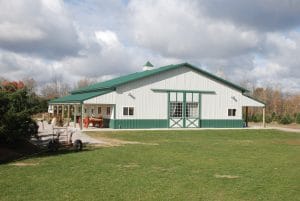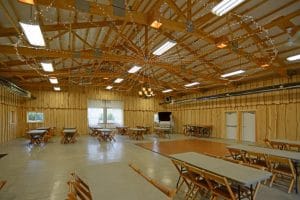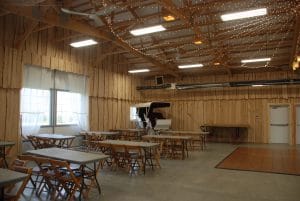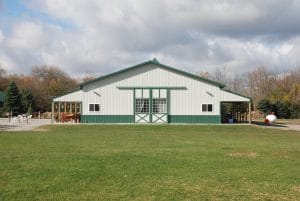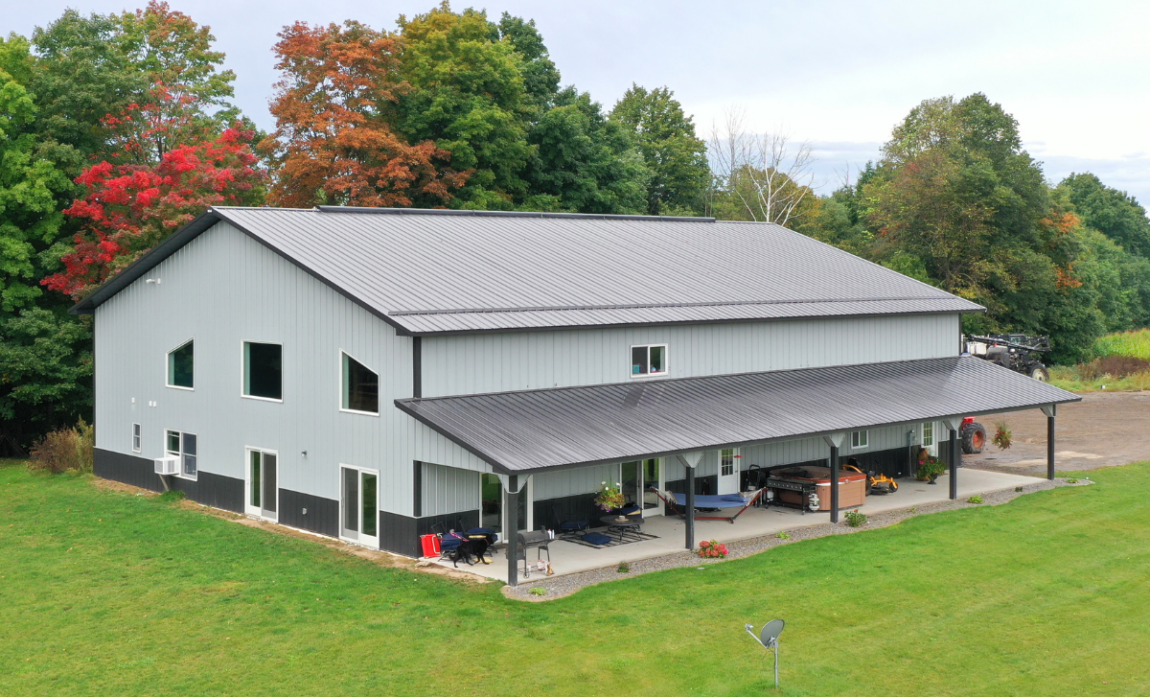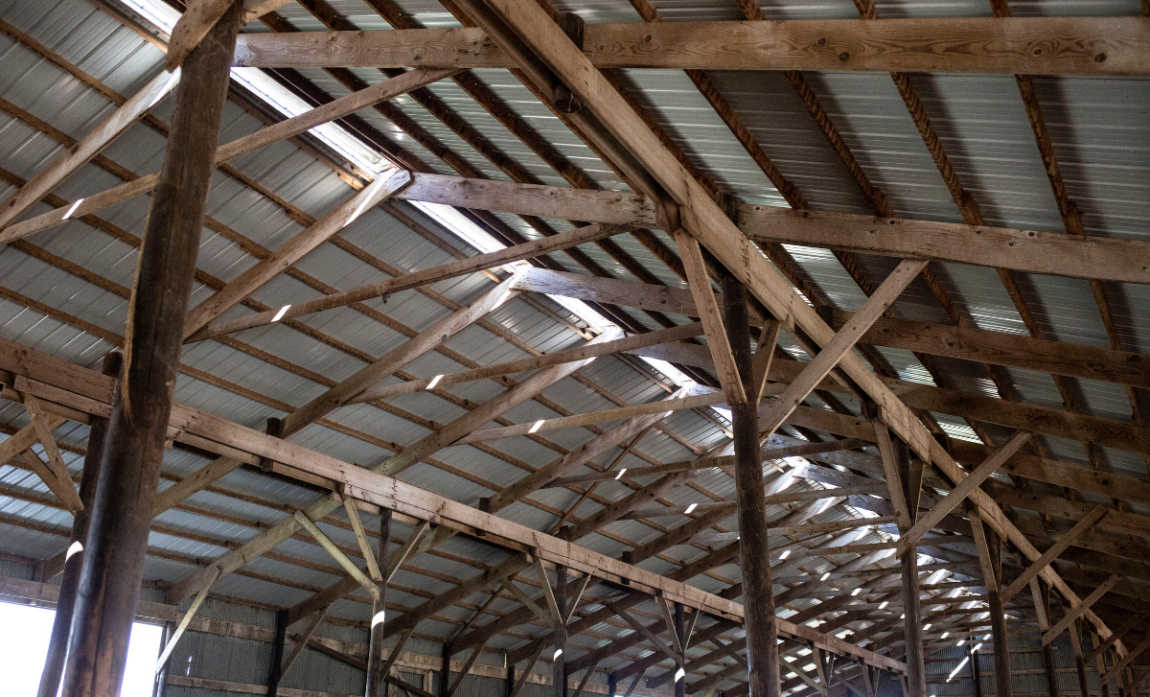A white-hot trend in building is the construction of event facilities on rural properties. The Peacock Road Family Farm is a perfect example of how an old tree farm can be reimagined into a thriving event facility — with a little help from a post-frame construction building.
Ed and Diane Carpenter are the owners of the Peacock Road Family Farm, situated just outside the city of Lansing, Michigan. For years, they had been operating it as a simple Christmas tree farm. But they had so many visitors, it seemed like more could be done with their property.
The Carpenters decided to create an entire Christmas experience. They added tractor rides, a petting zoo, and eventually they restored an old barn and turned it into a year-round facility.
With each new addition to the facility, even more new opportunities became apparent. It led them to call Keith Pinkelman of Lynnman Construction.
From a Tree Farm Sprouts a Wedding Facility
Most of the visitors to the tree farm were people from the suburbs. Because of the natural beauty of the area, the Carpenters were soon receiving requests for wedding facilities.
“The Carpenters realized they had a need for a banquet facility,” said Pinkelman. “Something that could hold weddings and Christmas parties for companies.”
Lynnman Construction is a Wick Buildings partner, and they’ve built hundreds of agricultural, commercial and suburban buildings. From that experience, Pinkelman could see that the challenge for this facility wouldn’t be in construction — it would be adhering to building codes.
Building Code Challenges Abound
As we’ve detailed in a previous post on building codes, these types of facilities must meet a variety of building code and zoning requirements. This can lead to additional costs. For example, if the facility exceeded a certain capacity, it would trigger the requirement of a fire sprinkler system.
In addition, the Carpenters’ wish list had to conform with modern-day requirements, which was another of Pinkelman’s challenges. “Everyone has their own ideas of what a facility should look like. Where should the entry doors go? Where will the tables be?” he said.
Lynnman had to balance the Carpenters’ ideas with the realities of the permitting process. Issues such as parking accessibility, accessible bathroom facilities — everything needed to be considered.
The Rural Experience Meets Modern-Day Business Codes
Conforming to the aesthetic goals and the building code reality prompted Pinkelman to take his customers on a different path from an old farmhouse rebuild. “We decided to take it in the opposite direction,” he said.
Instead, the plans changed to a brand new facility, one that resembled a horse barn. It included porches on either side, glass sliding doors — a “nice modern barn look.”
Lynnman Construction poured the concrete, built the building, and handled the electrical wiring, doors and windows. Then the Carpenters, or should we say the Carpenters’ carpenters, took it from there.
Adding the Rustic Touches
The Carpenters, who had a mill on-site, contracted the rest of the on-site work. This included adding elements to the finish work that gave it the old barn feeling.
For example, the Carpenters hung barn planking on the walls, and parked an old buggy in the corner. They also finished off a rustic outbuilding that sits 60 yards from the barn, and transformed it into an old saloon.
Lynnman Construction insulated the roof metal only, so that all the framing would be exposed. They also hung lighting from the rafters and exposed the ductwork, creating a more open feeling.
In the end, Lynnman Construction managed to balance the permitting requirements with the Carpenters’ vision. “This is all about getting people to experience the lifestyle of living on the farm,” he said.
Appearance and Other Post-Frame Building Advantages Over Steel
With these types of buildings, a post-frame building holds a distinct edge over steel construction. Pinkelman pointed out four key advantages:
1. Appearance: It’s much easier to put attractive features on a post-frame building, such as the barn plans used by the Carpenters. The buildings have higher-pitched roofs, which allow for overhangs and enhance the experience.
2. Efficiency: Steel is cooler than wood in the winter, and hotter in the summer. That makes it less efficient from heating and cooling than the post-frame approach.
3. Ventilation: A post-frame building allows for more natural ventilation.
4. Size: While you do have restrictions on how big you can make a building, smaller projects (25 – 30 thousand square feet) can prove to be more economical.
Pinkleman points out that he doesn’t have allegiance to either the steel or the post-frame approach. “It’s all based on what you’re trying to accomplish and how it lays out,” he said.
For the Carpenters, the ability to create a sizable, aesthetically-pleasing space that didn’t push into more costly permit requirements was critical. Post-frame construction was the answer.
A Trend That’s Become a Success Story
Is the Peacock Road Tree Farm part of an emerging trend? Absolutely, according to Pinkelman. “Everyone gets tired of going to the banquet hall,” he said. “They want to get out of town and experience something unique.”
He notes that last year, his company built one of these facilities. This year, they have three buildings planned. “People see the building on our website, or hear about similar facilities. Then they want to build one,” he said.
Whether or not these type of rural event facilities are a trend, the Carpenters are definitely enjoying their fair share of success. “In two years’ time, they went from eight weddings a year to over thirty,” Pinkelman said. “Mr. Carpenter never imagined it would be this successful.”

